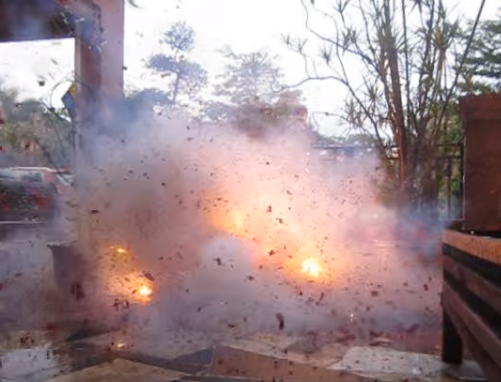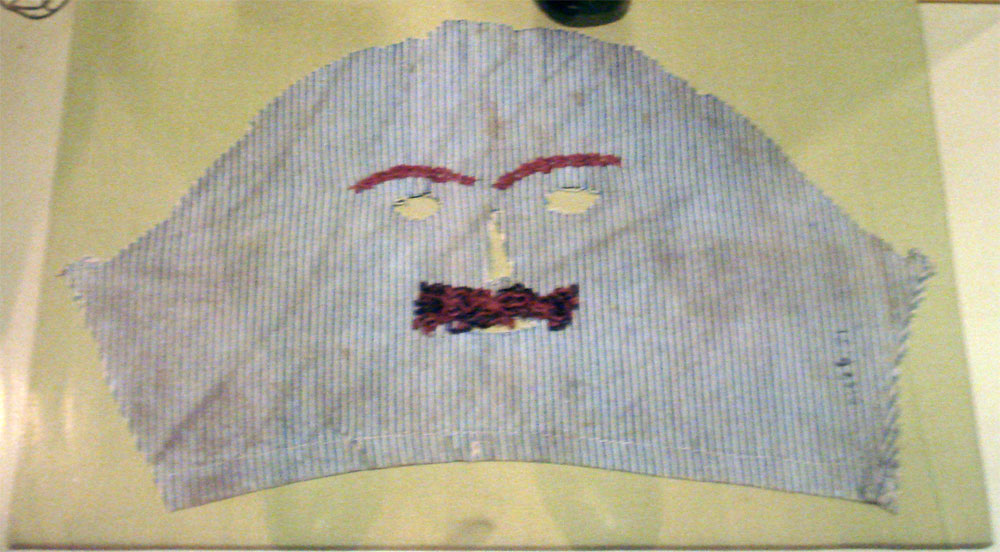|
Firecrackers
A firecracker (cracker, noise maker, banger) is a small explosive device primarily designed to produce a large amount of noise, especially in the form of a loud bang, usually for celebration or entertainment; any visual effect is incidental to this goal. They have fuses, and are wrapped in a heavy paper casing to contain the explosive compound. Firecrackers, along with fireworks, originated in China. History The predecessor of the firecracker was a type of heated bamboo, used as early as 200 BCE, that exploded when heated continuously. The Chinese name for firecrackers, ''baozhu'' (), literally means "exploding bamboo." After the invention of gunpowder, gunpowder firecrackers had a shape that resembled bamboo and produced a similar sound, so the name "exploding bamboo" was retained. In traditional Chinese culture, firecrackers were used to scare off enemies or evil spirits. Firecrackers production and sales Ingredients Firecrackers are generally made of cardboard or plas ... [...More Info...] [...Related Items...] OR: [Wikipedia] [Google] [Baidu] |
Fireworks
Fireworks are Explosive, low explosive Pyrotechnics, pyrotechnic devices used for aesthetic and entertainment purposes. They are most commonly used in fireworks displays (also called a fireworks show or pyrotechnics), combining a large number of devices in an outdoor setting. Such displays are the focal point of many cultural and religious Celebration (party), celebrations, though mismanagement could lead to List of fireworks accidents and incidents, fireworks accidents. Fireworks take many forms to produce four primary effects: noise, light, smoke, and floating materials (confetti most notably). They may be designed to burn with colored flames and sparks including red, orange, yellow, green, blue, purple and silver. They are generally classified by where they perform, either 'ground' or 'aerial'. Aerial fireworks may have their own Air propulsion, propulsion (skyrocket) or be shot into the air by a Mortar (weapon), mortar (aerial shell). Most fireworks consist of a paper or ... [...More Info...] [...Related Items...] OR: [Wikipedia] [Google] [Baidu] |
Diwali
Diwali (), also called Deepavali (IAST: ''Dīpāvalī'') or Deepawali (IAST: ''Dīpāwalī''), is the Hindu festival of lights, with variations celebrated in other Indian religions such as Jainism and Sikhism. It symbolises the spiritual victory of ''Dharma'' over ''Adharma'', light over darkness, good over evil, and knowledge over ignorance.Jean Mead, ''How and why Do Hindus Celebrate Divali?'', Diwali is celebrated during the Hindu calendar, Hindu lunisolar months of Ashvin (month), Ashvin (according to the Hindu calendar#amanta, amanta tradition) and Kartika (month), Kārtikabetween around mid-September and mid-November.''The New Oxford Dictionary of English'' (1998) – p. 540 "Diwali /dɪwɑːli/ (also Diwali) noun a Hindu festival with lights...". The celebrations generally last five or six days. Diwali is connected to various religious events, deities and personalities, such as being the day Rama returned to his Kosala, kingdom in Ayodhya (Ramayana), Ayodhya with h ... [...More Info...] [...Related Items...] OR: [Wikipedia] [Google] [Baidu] |
Tihar (festival)
Tihar (also known as Yamapanchak Deepawali) is a five-day spiritual and cultural Hindu festival of lights celebrated by Nepalese as well as by the Indian Gorkhas inhabiting Sikkim state and Territories (particularly the towns of Darjeeling and Kalimpong). Tihar is analogous to the Indian festival of Diwali, the festival of lights, but both are different Festival. Tihar is referred to as Yamapanchak Tihar in Kathmandu Valley by Newari Nepalis and Dipawali Tihar in Madhesh Province by Madhesi Nepalis. In the rest of Nepal and the Indian states of Sikkim and Gorkhaland, both Nepalis and Indian Gorkhas refer to Diwali as the Tihar Parwa. Like Diwali, it is marked by lighting '' diyo'' inside and outside the home, but unlike Diwali in other parts of India, the five days of Tihar include celebration and worship of the four creatures associated with the God of death Yama, with the final day reserved for people themselves. According to the Vikram Samvat calendar, the festiv ... [...More Info...] [...Related Items...] OR: [Wikipedia] [Google] [Baidu] |
Explosive
An explosive (or explosive material) is a reactive substance that contains a great amount of potential energy that can produce an explosion if released suddenly, usually accompanied by the production of light, heat, sound, and pressure. An explosive charge is a measured quantity of explosive material, which may either be composed solely of one ingredient or be a mixture containing at least two substances. The potential energy stored in an explosive material may, for example, be: * chemical energy, such as nitroglycerin or grain dust * pressurized gas, such as a gas cylinder, aerosol can, or boiling liquid expanding vapor explosion * nuclear energy, such as in the fissile isotopes uranium-235 and plutonium-239 Explosive materials may be categorized by the speed at which they expand. Materials that detonate (the front of the chemical reaction moves faster through the material than the speed of sound) are said to be "high explosives" and materials that deflagrate ar ... [...More Info...] [...Related Items...] OR: [Wikipedia] [Google] [Baidu] |
Halloween
Halloween, or Hallowe'en (less commonly known as Allhalloween, All Hallows' Eve, or All Saints' Eve), is a celebration geography of Halloween, observed in many countries on 31 October, the eve of the Western Christianity, Western Christian feast of All Saints' Day, All Hallows' Day. It is at the beginning of the observance of Allhallowtide, the time in the Christian liturgical year dedicated to remembering the dead, including saints (hallows), Christian martyr, martyrs, and all the faithful departed. In popular culture, Halloween has become a celebration of Horror fiction, horror and is associated with the macabre and the supernatural. One theory holds that many Halloween traditions were influenced by Celts, Celtic harvest festivals, particularly the Gaels, Gaelic festival Samhain, which are believed to have Paganism, pagan roots. Some theories go further and suggest that Samhain may have been Christianization, Christianized as All Hallows' Day, along with its eve, by the Ear ... [...More Info...] [...Related Items...] OR: [Wikipedia] [Google] [Baidu] |
Glassine
Glassine is a smooth and glossy paper which is air-, water-, and grease-resistant. It is usually available in densities between . It is translucent unless dyes are added to the paper to color it or make it opaque. It is manufactured by supercalendering: after pressing and drying, the paper web is passed through a stack of alternating steel-covered and fiber-covered rolls called a supercalender at the end of the paper machine so that the paper fibers are oriented in the same direction. Usage Glassine is most commonly used as a base for further silicone coating for the manufacture of release liner. Glassine is also used as an interleaving paper in bookbinding, especially to protect fine illustrations from contact with facing pages; the paper can be manufactured with a neutral pH and can prevent damage from spilling, exposure, or rubbing. Glassine adhesive tape has been used in book repair. In chemistry, glassine is used as an inexpensive weighing paper. It is applied in foodser ... [...More Info...] [...Related Items...] OR: [Wikipedia] [Google] [Baidu] |
Lewes Bonfire, LBBS, Banger Blitz
Lewes () is the county town of East Sussex, England. The town is the administrative centre of the wider Lewes (district), district of the same name. It lies on the River Ouse, Sussex, River Ouse at the point where the river cuts through the South Downs. A traditional market town and centre of communications, in 1264 it was the site of the Battle of Lewes. The town's landmarks include Lewes Castle, Lewes Priory, Bull House (the former home of Thomas Paine), Southover Grange and public gardens, and a 16th-century timber-framed Wealden hall house known as Anne of Cleves House. Other notable features of the area include the Glyndebourne festival, the Lewes Bonfire celebrations and the Lewes Pound. Etymology The place-name "Lewes" is first attested in an Anglo-Saxon charter circa 961 AD, where it appears as ''Læwe''. It appears as ''Lewes'' in the Domesday Book of 1086. The addition of the suffix seems to have been part of a broader trend of Anglo-Normans, Anglo-Norman scribes plu ... [...More Info...] [...Related Items...] OR: [Wikipedia] [Google] [Baidu] |
Southeast Asia
Southeast Asia is the geographical United Nations geoscheme for Asia#South-eastern Asia, southeastern region of Asia, consisting of the regions that are situated south of China, east of the Indian subcontinent, and northwest of the Mainland Australia, Australian mainland, which is part of Oceania. Southeast Asia is bordered to the north by East Asia, to the west by South Asia and the Bay of Bengal, to the east by Oceania and the Pacific Ocean, and to the south by Australia (continent), Australia and the Indian Ocean. Apart from the British Indian Ocean Territory and two out of Atolls of the Maldives, 26 atolls of the Maldives in South Asia, Maritime Southeast Asia is the only other subregion of Asia that lies partly within the Southern Hemisphere. Mainland Southeast Asia is entirely in the Northern Hemisphere. Timor-Leste and the southern portion of Indonesia are the parts of Southeast Asia that lie south of the equator. The region lies near the intersection of Plate tectonics, ... [...More Info...] [...Related Items...] OR: [Wikipedia] [Google] [Baidu] |
Independence Day (United States)
Independence Day, known colloquially as the Fourth of July, is a federal holiday in the United States which commemorates the ratification of the Declaration of Independence by the Second Continental Congress on July 4, 1776, establishing the United States of America. The Founding Father delegates of the Second Continental Congress declared that the Thirteen Colonies were no longer subject (and subordinate) to the monarch of Britain, King George III, and were now united, free, and independent states. The Congress voted to approve independence by passing the Lee Resolution on July 2 and adopted the Declaration of Independence two days later, on July 4. Independence Day is commonly associated with fireworks, parades, barbecues, carnivals, fairs, picnics, concerts, baseball games, family reunions, political speeches, and ceremonies, in addition to various other public and private events celebrating the history, government, and traditions of the United State ... [...More Info...] [...Related Items...] OR: [Wikipedia] [Google] [Baidu] |







